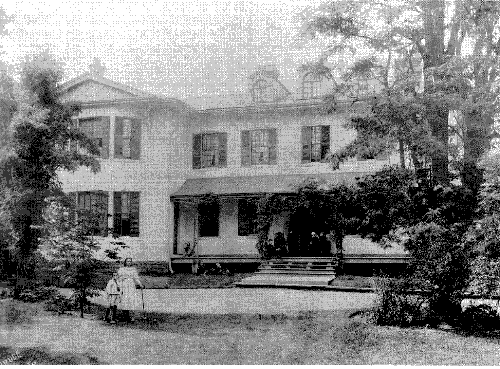
In 1839, George Taylor Denison II, newly married to Mary Anne Dewson, built Rusholme on property given him by his father. He named it after the property of a relative in the old country. White gates and a gabled gatekeeper’s cottage marked the entrance to the curving carriage drive from the corner of modern Dundas and Rusholme Streets. Denison was a prominent lawyer, soldier and entrepreneur. He succeeded his father and brother as commander of the Governor General’s Body Guard. He managed Rusholme’s fields and orchards so that they became a model of productive, scientific farming. Some of his wealth came from the sale of land. With rising property values, their land was worth up to £200 ($800) an acre.

The Denisons lived the life of country squires, with their mansions protected by forests and fields, even as they subdivided nearby land. Rusholme was at the centre of a cosmopolitan of social life with balls and soirees and was visited by a number of royal and military personalities including General Robert E. Lee. Denison sympathized with the Confederate cause as Mary Anne’s brother, George Dewson, was a colonel in the Confederate Army. Denison died in 1873. Rusholme Road was subdivided in 1883 and, by 1884, the property surrounding the house had been reduced to a square bounded by Dovercourt Road, St. Anne’s Road, Rusholme Street, and College Street.
His second son, Frederick, inherited the house as George Taylor Denison III, the eldest had built his own home, Heydon Villa, only a short distance to the north-east. Frederick added a ballroom and a library and filled Rusholme’s twenty-one rooms with his eight children. Frederick Denison followed in the military tradition of the family. In 1884, he accompanied the Wolseley expedition with a crew of Canadian voyageurs, up the Nile in the unsuccessful attempt to rescue General Gordon at Khartoum.
In later years the house became run down, so after Frederick’s son died in 1953, it was demolished to make way for apartments. Rusholme had been home to a dynasty. For 115 years it had been occupied by a single family noted for the part it played in the development of this city. Its men had seen service in every war in which Canada had played a part. It is of interest to note that Rusholme had gas lighting well into the age of electricity and was one of the last homes in Toronto to be electrified. The names of nearby street keep the memory of Rusholme: Rusholme Park Crescent, Rusholme Road, Rusholme Drive, and Dewson Street.
For notes about other Denison and their houses on this site see Brookfield, Bellevue, Dover Court and Heydon Villa.
For more about Rusholme and the Denisons, see “The Estates of Old Toronto” by Liz Lundell.
